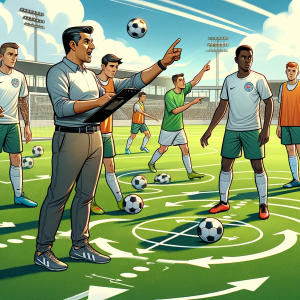
Seven Simple Steps to Scout Soccer Talent Better
When it comes to scouting soccer talent, how accurate are the decisions made on the field or in the office? Most scouts rely on their expert judgment, but recent research shows that adding a little more structure can make a world of difference. A study applied the Lens Model to soccer scouting, revealing that while experts might be great at gathering information, they aren’t always the best at combining it. The result? Missed opportunities, misjudged players, and less-than-optimal team decisions. By learning to blend objective stats with the human touch, soccer scouts can transform their ability to spot and nurture top talent.
The Expert’s Eye: What’s Missing?
Imagine a scout at the sidelines of a local game. They watch a player dribble, assess their speed, note how well they read the game, and decide, “This player has potential!” That gut feeling is the scout’s clinical judgment in action. They’re combining all the cues—how fast the player runs, their technique, their stamina—but not in a systematic way. It feels natural because it’s how they’ve always done it.
The problem is that clinical judgment, while intuitive, is often inconsistent. One game, a scout might prioritize speed; in another, they might value technical skill. This inconsistency introduces noise—random errors that can sway a decision the wrong way. While a scout’s deep experience is invaluable, relying solely on intuition may lead to suboptimal choices. What if there was a better way to harness that expertise while cutting down on judgment errors?
Enter the Lens Model: A New Perspective
The Lens Model, originally developed for human judgment research, is now helping soccer scouts improve the accuracy of their assessments. The model breaks down the process of decision-making into two key parts: what information is collected (like a player’s sprinting speed or passing accuracy) and how that information is combined to make a final judgment.
It’s like solving a puzzle: you have all the pieces (the player’s stats, skills, and performance), but if you put them together in the wrong way, the picture won’t be clear. The Lens Model helps coaches and scouts assemble these pieces in a more structured, consistent manner. When done right, the result is a sharper, more accurate evaluation of a player’s true potential.
Why Consistency is Key
Consider this analogy: Imagine you’re baking a cake. You have all the ingredients—flour, sugar, eggs, butter. If you use a different amount of each every time, your cake will turn out differently each time. It might still be edible, but it’s unlikely to be perfect every time. The same principle applies to player assessments. When scouts combine the information they gather inconsistently, it’s like changing the recipe every time—they may still make decent decisions, but those decisions are far from optimal.
Research in the field of soccer scouting shows that even a scout’s personal “recipe” for evaluating players can become more accurate if they apply it consistently. The study found that when scouts applied their own criteria uniformly, their evaluations became significantly more reliable.
The Power of Actuarial Judgment
Now, imagine if you didn’t have to rely on inconsistent judgment alone. Instead, you could use a more scientific approach—one that consistently weighs a player’s stats and performance indicators to make a final call. This is known as actuarial judgment, and it’s the secret weapon behind the Lens Model.
In actuarial judgment, scouts use a predetermined rule—like a formula—to combine all the factors they’re observing. For example, a scout might rate players on a scale based on their passing accuracy, speed, and stamina, then use a formula to calculate a final score. The key is that this formula stays the same for every player, removing the variability that often sneaks into subjective judgments.
The study showed that using actuarial methods, even in combination with clinical judgment, led to more accurate assessments than relying on intuition alone. The result? Less randomness, more consistency, and better decisions.
Seven Steps of the Lens Model for Soccer Scouting
The Lens Model provides a framework to help soccer scouts combine their intuitive assessments with a structured, data-driven approach. Below are the seven key steps in applying this model to soccer scouting:
- Define the Performance Criterion: Identify the specific outcome or criterion you want to predict, such as a player’s future success on the team or their transfer value. This is the “end goal” that the scout’s judgment aims to assess.
- Select Relevant Cues: Choose the information (or “cues”) scouts will use to make their decisions. These can be objective measures like sprinting speed or passing accuracy or subjective assessments like game intelligence.
- Judge Each Player Based on Cues: Using these cues, scouts evaluate each player. Traditionally, this is done through clinical judgment, but in the Lens Model, the key is applying these judgments systematically.
- Develop a Judgment Policy: This step involves analyzing how scouts combine the different cues to make their final judgment. The goal is to understand their “judgment policy” by determining which cues they prioritize.
- Measure Cognitive Control: Cognitive control refers to how consistently scouts apply their judgment policy across all players. The more consistent their approach, the less noise and random error is introduced into the decision-making process.
- Compare Judgment Accuracy: Evaluate the accuracy of the scout’s judgments by comparing them to the actual performance criterion. This step helps to highlight whether a more consistent or actuarial approach would improve judgment accuracy.
- Refine and Optimize the Policy: Once the scout’s judgment policy is understood, adjustments can be made to improve it. This could involve using an actuarial model to combine cues more systematically or adjusting the weights given to each cue.
Real-World Impact: How the Lens Model Helps
Let’s put this into practice. Imagine a soccer club is looking to sign a new central defender. The club’s scouts are tasked with evaluating 50 players, considering skills like tackling, sprinting speed, and game insight. Without a structured system, each scout might weigh these skills differently—some putting more emphasis on tackling, others on speed.
The Lens Model suggests a solution. By applying a consistent rule that optimally combines these skills, the club can ensure that every scout evaluates players on the same basis, leading to more accurate rankings. As a result, the club is more likely to sign a player who truly fits their needs rather than someone who just impressed one scout on the day.
Why Not Just Rely on Algorithms?
You might wonder, “Why not just let an algorithm make the decision?” It’s a valid question—after all, algorithms have proven incredibly effective in many areas, from medicine to finance. However, in soccer, where so many intangibles come into play—like a player’s mental toughness or ability to lead a team—the human element is still crucial.
The beauty of the Lens Model is that it doesn’t replace the human element; it enhances it. By blending the best of both worlds—expert intuition and structured, evidence-based rules—the model allows scouts to make better decisions without losing the nuance that comes with years of experience.
Applications: How to Use This in Coaching and Player Development
So, how can soccer coaches, scouts, and clubs apply these insights? Here are a few key takeaways:
- Consistent Evaluation: Develop a standardized system for player assessments, ensuring that every scout or coach evaluates players using the same criteria. This will remove randomness and increase the chances of identifying the right talent.
- Blending Intuition with Data: Don’t throw out the expert’s eye—just support it with objective data. Use statistical models to weigh players’ attributes consistently, but leave room for human judgment in areas that numbers can’t capture, like leadership or adaptability.
- Training for Accuracy: Train scouts to apply their judgment policies uniformly to help them become more consistent. The study found that simply being more consistent in applying their own judgment rules made scouts more accurate.
- Team Selection: When selecting players, consider using an actuarial model to ensure that all the important factors—like technical skill, speed, and tactical awareness—are considered equally for each candidate.
Conclusion: A Winning Combination
In the high-stakes world of soccer scouting (yes, even at the youth level), making the right call can mean the difference between a championship team and a missed opportunity. By combining the power of human expertise with the consistency of actuarial judgment, the Lens Model offers a clear path to improving talent assessments. Coaches and scouts who embrace this method won’t just find better players—they’ll build stronger, more successful teams.


